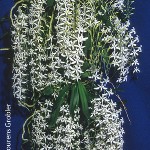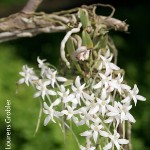Mystacidium
Mystacisidum is a genus endemic to Africa and contains ten species, seven of which are found in South Africa. Plants are epiphytic and monopodial with strap-shaped leaves opposite each other in a row. Stems are generally short. an extensive root system anchors the plants to the host tree or plant. Pendant flowering stems with up to 13 white or greenish flowers are borne from amongst or below the leaves. Sepals are similar in size and shape while the petals are generally smaller than the sepals. A long, tapering spur is filled with nectar at the end and flowers are scented from dusk to dawn and generally pollinated by moths.
Credit
Johnson, S.D., Bytebier, B., Stärker, H. (2010). Orchids of South Africa: A field guide. Struik Nature, Cape Town, South Africa.
Mystacidium capense
Description
Slender epiphyte with stems of 10-25 mm long. Leaves strap-shaped, unequally bilobed, up to 120 mm long and 22 mm wide. Inflorescences lateral, one to several, up to 180 mm long, laxly flowered. Up to 13 flowers are white with a glistening texture, 25-30 mm in diameter, sepals and petals similar, linear to spear-shaped, spur tapering, up to 60 mm long. Similar to Mystacidium venosum. Pollinated by hawkmoths. Colony forming. Fragrance sweet, jasmine-like at night.
Mystacidium venosum
Description
Miniature epiphyte with stems 10-15 mm long. Leaves strap-shaped to elliptic, unequally bilobed, up to 45 mm long and 10 mm wide, often poorly developed or absent. Inflorescences, one to several, up to 50mm long,4-10 flowers, white and 15 mm in diameter. Petals and sepals reflexed, spur tapering, up to 45 mm long. Similar to Mystacidium capense, distinguished by different flowering time and shorter leaves and spur. Pollinated by hawk moths. Fragrance sweet, scented at night.
For more information regarding the preservation of South Africa's wild Orchids or if you would like to get involved please email This email address is being protected from spambots. You need JavaScript enabled to view it. or complete this short form Contact Us and we will contact you.



